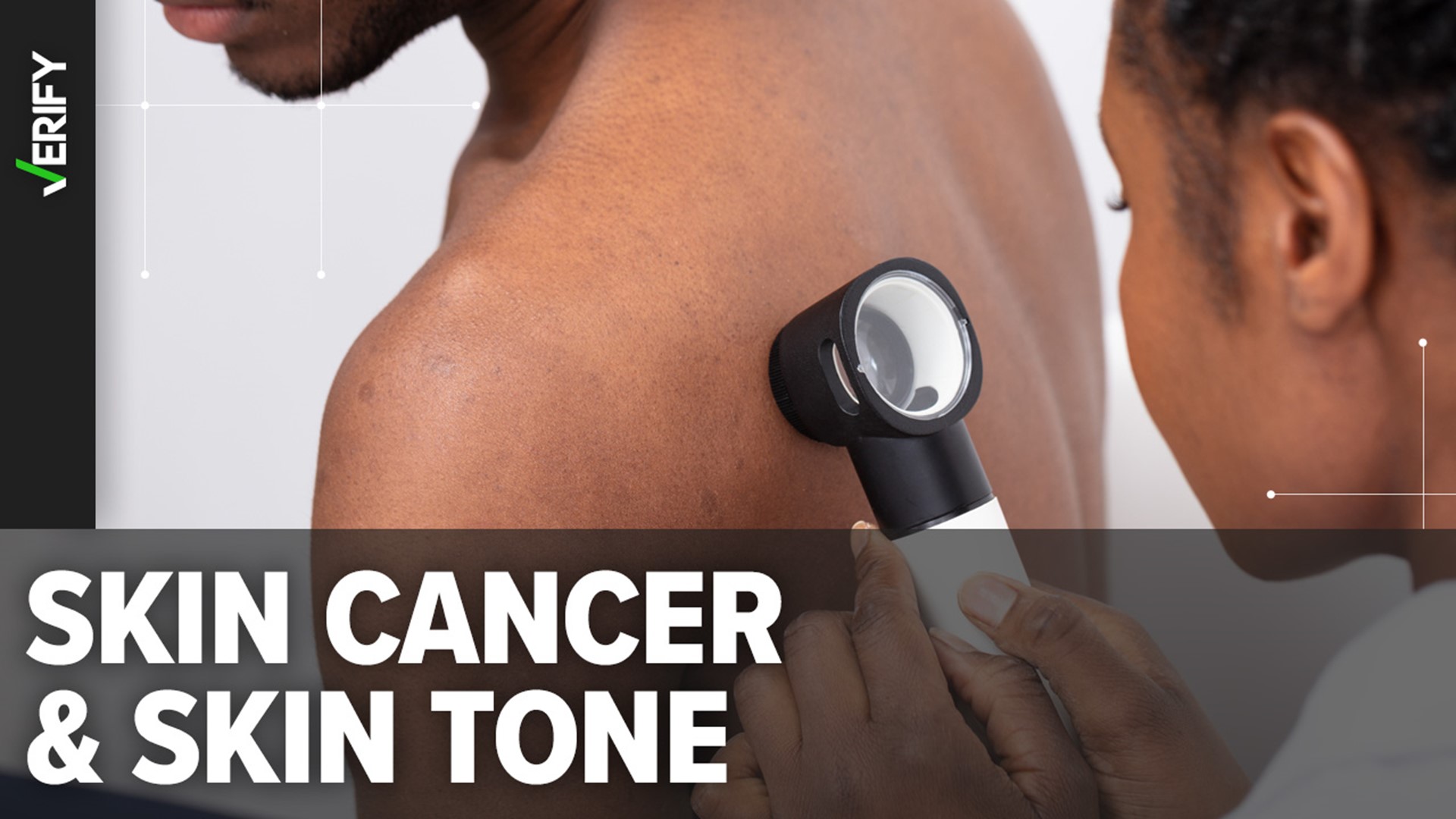Skin cancer is the most common type of cancer in the United States, but it is also one of the most treatable forms of cancer when caught early.
There are some common misconceptions about skin cancer and skin tone, such as the belief that people of color aren’t at risk of developing the disease or that people with darker skin tones don’t need to apply sunscreen.
We’re VERIFYING four facts about skin cancer and skin tone, and sharing tips on how to reduce your risk of developing the disease.
THE SOURCES
- U.S. Centers for Disease Control and Prevention (CDC)
- National Cancer Institute
- American Cancer Society
- The Skin Cancer Foundation
- American Academy of Dermatology
- Institute for Quality and Efficiency in Health Care (IQWiG)
- Mayo Clinic
- Cleveland Clinic
- Columbia University Irving Medical Center
- The University of Texas MD Anderson Cancer Center
- UPMC Western Maryland
- UNC Health
- Keck Medicine of USC
- Medical News Today
- Corey L. Hartman, M.D., board-certified dermatologist at Skin Wellness Dermatology in Birmingham, Alabama
QUESTION #1
Does having a darker skin tone protect you from getting skin cancer?
ANSWER #1
No, having a darker skin tone does not protect you from getting skin cancer.
WHAT WE FOUND
While having a darker skin tone does provide some protection against the sun’s harmful ultraviolet (UV) rays, it’s a myth that people with darker skin tones are immune to developing skin cancer, according to the Columbia University Irving Medical Center, the Cleveland Clinic, the University of Texas MD Anderson Cancer Center and Keck Medicine of USC.
“No matter what color your skin is, if you’re exposed to the sun, there’s a possibility that you can get skin cancer,” the Cleveland Clinic says on its website.
Skin cancer is the out-of-control growth of abnormal cells in the epidermis, the outermost skin layer, caused by unrepaired DNA damage that triggers mutations, according to the Skin Cancer Foundation. These mutations lead the skin cells to multiply rapidly and form malignant tumors.
There are three major types of skin cancer: basal cell carcinoma, squamous cell carcinoma and melanoma. Basal and squamous cell carcinomas begin in the basal and squamous layers of the skin. While melanoma begins in the melanocytes, which are cells that make melanin — the pigment that gives skin its color, according to the CDC.
Skin cancer typically develops on areas of sun-exposed skin, including the scalp, face, lips, ears, neck, chest, arms, hands and on the legs, the Mayo Clinic says. It can also form on areas that rarely see the light of day, such as the palms, beneath fingernails or toenails, and in the genital area.
“People with dark skin may have the misconception that they are immune to skin cancer because their skin has more melanin or pigment. While they are less likely to get skin cancer, they are still at risk,” said Ana Ciurea, M.D., a dermatologist at the MD Anderson Cancer Center.
Keck Medicine of USC says this misconception can be devastating because skin cancer in people of color is often diagnosed at later stages, when the disease may be more advanced and harder to treat.
“One of the most dangerous types of skin cancer, melanoma, starts from those melanin cells or melanocytes that produce the melanin. So when darker-skinned people do get skin cancer, it tends to develop in those types of cells and it tends to be more deadly,” dermatologist Corey L. Hartman, M.D. told VERIFY.
Along with sun exposure, there are several other factors that may contribute to the risk of developing skin cancer. Those factors include having a family history of skin cancer, having many moles or abnormal moles on your body, being exposed to toxic substances and having a condition that weakens the immune system.
QUESTION #2
Does skin cancer look different on different skin tones?
ANSWER #2
Yes, skin cancer looks different on different skin tones.
WHAT WE FOUND
Skin cancer can look quite different from one person to another due to skin tone, the size and type of skin cancer, and the location on the body, according to the Skin Cancer Foundation.
Medical News Today says people with lighter skin tones may develop cancerous growths that appear different in color from their surrounding skin, making them more noticeable. But in individuals with darker skin tones, these growths may be skin-colored and therefore less noticeable and harder to detect, which could lead to a delay in skin cancer diagnosis.
“Darker skin has more melanin in concentrated areas like around the nail beds, on moles on the palms and the soles, and those are areas that people don't necessarily think of to look for skin cancer,” said dermatologist Corey L. Hartman. “So, by the time you notice something, a small change in an area that you're not really used to focusing on, it tends to be at a later stage.”
The American Academy of Dermatology says people of color and those with darker skin tones should check their own skin from head to toe monthly for signs of skin cancer. They recommend looking for the following:
- Dark spot, growth or darker patch of skin that is growing, bleeding or changing in any way
- Sore that won’t heal — or heals and returns
- Sore that has a hard time healing, especially if the sore appears in a scar or on skin that was injured in the past
- Patch of skin that feels rough and dry
- Dark line underneath or around a fingernail or toenail
Hartman, the American Academy of Dermatology and the Skin Cancer Foundation all recommend seeing a dermatologist at least once a year for a full body exam, especially if you notice anything new, changing or unusual on your skin.
QUESTION #3
Are people with pale or lighter skin more at risk for skin cancer?
ANSWER #3
Yes, people with pale or lighter skin are more at risk for skin cancer.
WHAT WE FOUND
Anyone can get skin cancer, but people with pale or lighter skin have a greater risk of developing it, according to the National Cancer Institute, UPMC Western Maryland and the Skin Cancer Foundation.
“Traditionally, skin cancer has always been a topic that’s associated with fair-skinned people because of the exposure to UV light and the damage that the sun can do to lighter skin because of the lack of protection of natural melanin,” dermatologist Corey L. Hartman said.
According to the scientific classification known as Fitzpatrick skin typing, there are six types of skin, ranging from very light (type 1) to very dark (type 6). The Fitzpatrick system classifies skin type according to the amount of skin pigment you have and your skin’s reaction to sun exposure.
“Determining your Fitzpatrick skin type can help predict your overall risk for sun damage and skin cancer,” the Skin Cancer Foundation says.
Typically, people who have fair skin (types 1 and 2) have a pale complexion, often with freckles; light-colored eyes, such as blue or green; red or blond hair; and either never get a tan or only tan a little. These factors make people with pale or lighter skin more sensitive to sunlight and very prone to sunburn, which increases their skin cancer risk, according to the Institute for Quality and Efficiency in Health Care (IQWiG).
“People with lighter colored hair, eyes and skin have a greater risk of developing skin cancer because their body contains less melanin that protects them from sun damage,” UPMC Western Maryland says.
QUESTION #4
Do people with darker skin tones need to wear sunscreen?
ANSWER #4
Yes, people with darker skin tones need to wear sunscreen.
WHAT WE FOUND
Everyone, including people with darker skin tones, needs to wear sunscreen every day, according to the Skin Cancer Foundation, the University of Texas MD Anderson Cancer Center and UNC Health.
The American Academy of Dermatology recommends that people with darker skin tones use a water-resistant sunscreen that has broad-spectrum protection and an SPF of 30 or greater. You should apply sunscreen to dry skin 15 to 30 minutes before going outdoors — even on cloudy days — then reapply it every two hours, as well as immediately after sweating or swimming.
“Everybody should wear sunscreen, it should be in the range of 30 to 50, to make sure you're getting as much protection as possible,” dermatologist Corey L. Hartman said.
Putting on broad-spectrum sunscreen that blocks both UVA and UVB rays can help decrease your risk of skin cancer, UNC Health says. Sunscreen also helps prevent hyperpigmentation and premature skin aging, including wrinkles, sagging and age spots.
In addition to wearing sunscreen, you can protect yourself from sun exposure and reduce your risk of getting skin cancer by doing the following:
- Seeking shade whenever possible.
- Wearing clothing that protects your skin from the sun, such as a wide-brimmed hat that can shade your face and neck, shoes that cover the entire foot and sunglasses with broad-spectrum protection.
- Never using tanning beds or sunlamps because these emit harmful UV rays, which can cause skin cancer.












